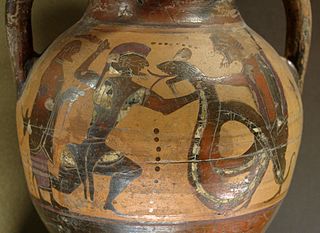
In Norse mythology, Brísingamen is the torc or necklace of the goddess Freyja. The name is an Old Norse compound brísinga-men whose second element is men "(ornamental) neck-ring, torc". The etymology of the first element is uncertain. It has been derived from Old Norse brísingr, a poetic term for "fire" or "amber" mentioned in the anonymous versified word-lists (þulur) appended to many manuscripts of the Prose Edda, making Brísingamen "gleaming torc", "sunny torc", or the like. However, Brísingr can also be an ethnonym, in which case Brísinga men is "torque of the Brísings"; the Old English parallel in Beowulf supports this derivation, though who the Brísings may have been remains unknown.

The Æsir are the gods of the principal pantheon in Norse religion. They include Odin, Frigg, Höðr, Thor, and Baldr. The second Norse pantheon is the Vanir. In Norse mythology, the two pantheons wage war against each other, resulting in a unified pantheon. Unlike the Old English word god, Æsir was never converted over to Christian use.

In Norse mythology, the Vanir are a group of gods associated with fertility, wisdom, and the ability to see the future. The Vanir are one of two groups of gods and are the namesake of the location Vanaheimr. After the Æsir–Vanir War, the Vanir became a subgroup of the Æsir. Subsequently, members of the Vanir are sometimes also referred to as members of the Æsir.

Saint Seiya, also known as Saint Seiya: Knights of the Zodiac or simply Knights of the Zodiac, is a Japanese manga series written and illustrated by Masami Kurumada. It was serialized in Shueisha's shōnen manga magazine Weekly Shōnen Jump from 1986 to 1990, with its chapters collected in twenty-eight tankōbon volumes. The story follows five mystical warriors called the Saints who fight wearing sacred sets of armor named "Cloths", the designs of which derive from the various constellations the characters have adopted as their destined guardian symbols, and empowered by a mystical energy called "Cosmo". The Saints have sworn to defend the reincarnation of the Greek goddess Athena in her battle against other Olympian gods who want to dominate Earth.

In ancient Greek religion and mythology, the twelve Olympians are the major deities of the Greek pantheon, commonly considered to be Zeus, Hera, Poseidon, Demeter, Athena, Apollo, Artemis, Ares, Hephaestus, Aphrodite, Hermes, and either Hestia or Dionysus. They were called Olympians because, according to tradition, they resided on Mount Olympus.

Valhalla is a Danish comic series, which offers a comedic view of the gods of Norse mythology. Originally commissioned for and published by Interpresse, it has been published by Carlsen Comics since 1978. In 1986, Valhalla was adapted into an animated feature film the studio A Film. On October 10, 2019, a more serious and dark live action adaptation was released.
Comic and manga adaptations of The Legend of Zelda series of video games, especially in Japan, have been published under license from Nintendo.

The Mythical Detective Loki Ragnarok is a manga by Sakura Kinoshita published from August 1999 to October 2004. A television anime based on the manga series ran for 26 episodes from April 5, 2003, to September 27, 2003, in Japan.

Holly Black is an American writer and editor best known for her children's and young adult fiction. Her most recent work is the New York Times bestselling young adult Folk of the Air series. She is also well known for The Spiderwick Chronicles, a series of children's fantasy books she created with writer and illustrator Tony DiTerlizzi, and her debut trilogy of young adult novels officially called the Modern Faerie Tales. Black has won an Eisner Award, a Lodestar Award, a Award, a Nebula Award, and a Newbery honor.
The Norse mythology, preserved in such ancient Icelandic texts as the Poetic Edda, the Prose Edda, and other lays and sagas, was little known outside Scandinavia until the 19th century. With the widespread publication of Norse myths and legends at this time, references to the Norse gods and heroes spread into European literary culture, especially in Scandinavia, Germany, and Britain. In the later 20th century, references to Norse mythology became common in science fiction and fantasy literature, role-playing games, and eventually other cultural products such as Japanese animation. Storytelling was an important aspect of Norse mythology and centuries later, with the rediscovery of the myth, Norse mythology once again relies on the impacts of storytelling to spread its agenda.

Richard Russell Riordan Junior is an American author, best known for writing the Percy Jackson & the Olympians series. Riordan's books have been translated into forty-two languages and sold more than thirty million copies in the United States. 20th Century Fox adapted the first two books of his Percy Jackson series as part of a series of films, while a Disney+ adaptation is in production. His books have spawned related media, such as graphic novels and short story collections.
The Salariya Book Company is an independent publishing house based in Brighton, United Kingdom, which publishes children’s non-fiction, fiction and baby books both domestically and internationally. Salariya books are published in the UK through its Book House, Scribblers and Scribo imprints.

Kagura is a type of Shinto ritual ceremonial dance. The term is a contraction of the phrase kami no kura, indicating the presence of gods in the practice.

Asterix Conquers Rome, first published in 1976, is the comic book adaptation of the animated Asterix film The Twelve Tasks of Asterix and "unofficially" the twenty-third Asterix volume to be published. The comic follows the movie very exactly. It has very rarely been printed and is not widely known even amongst Asterix fans. The English translation has only been printed as part of a one-off comic book annual, the Asterix Annual 1980. It is thus often excluded from "canonical" lists of Asterix volumes with the subsequently published Obelix and Co. typically being listed as the "official" twenty-third volume. An unauthorized English language digital edition in CBR format, titled The Twelve Tasks of Asterix, is also known to exist.

Bryan Perro is the author of the children's fantasy fiction series Amos Daragon, a series of twelve novels that focus on the adventurous young adult Amos Daragon and his quest to become the 'Mask Wearer'.

Norse, Nordic, or Scandinavian mythology is the body of myths belonging to the North Germanic peoples, stemming from Old Norse religion and continuing after the Christianization of Scandinavia, and into the Nordic folklore of the modern period. The northernmost extension of Germanic mythology and stemming from Proto-Germanic folklore, Norse mythology consists of tales of various deities, beings, and heroes derived from numerous sources from both before and after the pagan period, including medieval manuscripts, archaeological representations, and folk tradition.

The Temples of Mount Hermon are around thirty Roman shrines and Roman temples that are dispersed around the slopes of Mount Hermon in Lebanon, Israel and Syria. A few temples are built on former buildings of the Phoenician & Hellenistic era, but nearly all are considered to be of Roman construction and were largely abandoned during the persecution of pagans in the late Roman Empire.
David Salariya is a founder of Salariya Book Company.
Adeline Foo is a Singaporean short story writer and children's book writer.

Calimacil Probotik inc. is a Canadian manufacturer located in Sherbrooke, Quebec. Founded in 2003 by Patrick Lessard, its name comes from an elven language created by author J. R. R. Tolkien: cali meaning light and macil meaning sword. This company specializes in the creation, manufacturing and distribution of foam weapons used in LARP, historical reenactment, movies and TV series.















